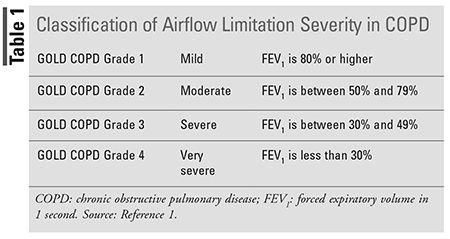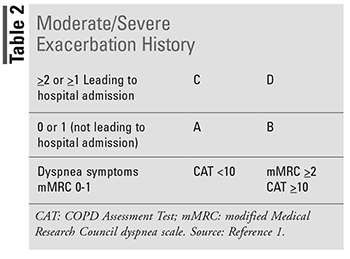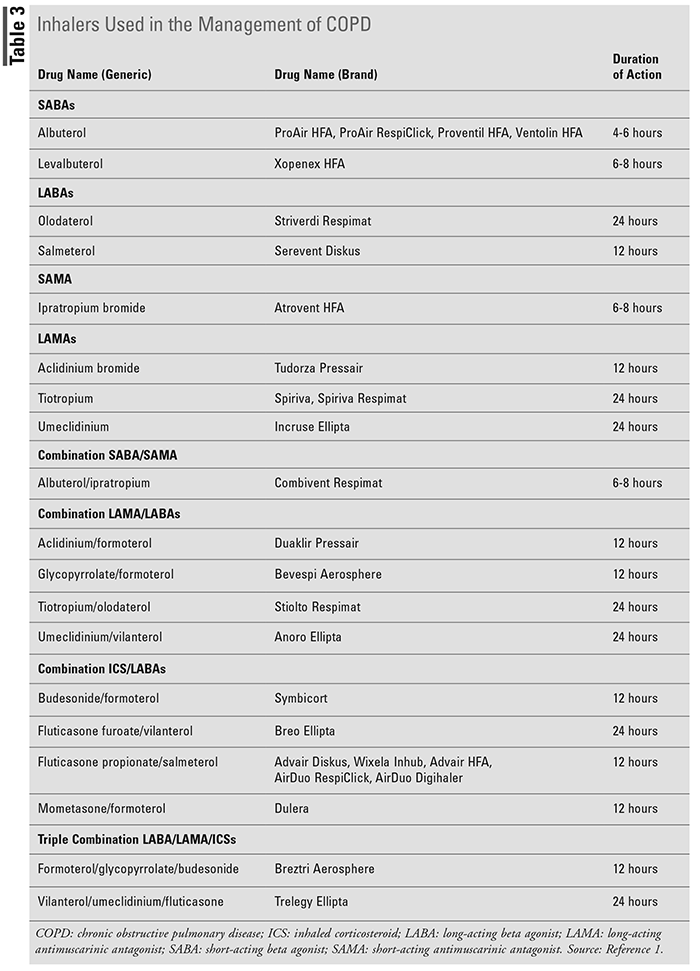US Pharm. 2021;46(11):51-56
Chronic obstructive pulmonary disease (COPD) is a slow-progressing, inflammatory respiratory disorder generally associated with smoking tobacco that can eventually lead to chronic respiratory failure. The Global Initiative for Chronic Obstructive Lung Disease (GOLD) defines COPD as a common, preventable, and treatable disease. COPD can be thought of as an umbrella term for a variety of clinical entities resulting in airflow limitation that is not fully reversible. It is characterized by persistent respiratory symptoms and airflow limitation that results from airway and/or alveolar abnormalities commonly caused by exposure to noxious gases or particles. Chronic inflammation of the airways eventually leads to thickening of airway walls, increased mucus production, and eventual permanent changes in the lungs’ structure.1-3
The incidence of COPD is highest in those who smoke or have a history of tobacco use, especially in those who smoked one pack per day for 20 years or longer. Smoking has been shown to increase the likelihood of developing COPD by a factor of five. It is also more prevalent in patients older than age 40 years, with studies suggesting most diagnoses occur between the ages 40 and 64 years. Prevalence is greater among males; however, projections estimate this difference will diminish in the future due to the increase in females smoking, as well as the increased exposure to biomass combustion products in developing nations.1,4
COPD affects approximately 16 million Americans, but this is likely an underestimate given that the condition remains underdiagnosed. COPD accounts for approximately 1.5 million emergency room visits, 699,000 hospitalizations, and 10.3 million office visits yearly. It causes significant morbidity and mortality; in the United States, chronic lower respiratory disease, primarily COPD, is the fourth-leading cause of death. COPD symptoms can be debilitating and adversely affect quality of life, leading to limitations in daily life and work productivity, ranking as the eighth-leading cause of disability-adjusted life-years in 2015. This condition also causes significant economic burden, with direct costs estimated to be about $32 billion in 2010 and indirect costs accounting for an additional $20.4 billion.1,3,5-9
Managing patients with COPD is multifaceted, and patient education is pivotal. Adherence to inhaled and oral medications in COPD has been reported to range between 41% to 57%, with almost a third of patients receiving inappropriate doses due to poor inhaler techniques. Pharmacists play a major role in management by helping to ensure that patients adhere to their treatment plan and by helping and encouraging them to adopt lifestyle changes, especially smoking cessation.10
Risk Factors
Although cigarette smoking is one of the major risk factors for the development of COPD, it is not the only one. Data from observational studies are showing nonsmokers may also develop airflow limitation, although when compared with smokers, the nonsmokers experience milder disease, fewer symptoms, and lower burden of systemic inflammation. Other environmental and genetic factors contribute to the development of COPD. The most common genetic factor found to increase a patient’s risk for COPD development is a serine protease alpha-1-antitrypsin deficiency, found in up to 3% of COPD patients. Long-term exposure to lung irritants, such as secondhand smoke, air pollution, fumes, or chemicals from the environment, can also increase the risk of COPD. Other factors, such as premature birth, uncontrolled asthma, and severe respiratory tract infections during childhood, can also increase the risk of COPD.1,2,6
Clinical Presentation/Screening
Common symptoms of COPD include exertional dyspnea, sputum production, chest tightness, cough, and fatigue.2 As COPD progresses, the symptoms worsen, but dyspnea is the most problematic and can lead to an increase in mortality and decrease in quality of life. Most patients with COPD are identified after they have experienced one or more exacerbations. Early detection and treatment are key to helping patients improve and preserve lung function and improve quality of life. Identification of COPD is made through a screening test involving a questionnaire and a postbronchodilator spirometry test. Spirometry is required to make an official diagnosis. The 2021 GOLD guidelines recommend that spirometry be limited to patients who require urgent or essential testing for diagnosis and/or to assess lung function for interventional procedures or surgery. The spirometry test should be conducted after an inhaled bronchodilator is administered. A postbronchodilator forced expiratory volume in one second (FEV1) to forced vital capacity (FVC) ratio of less than 0.7 confirms the presence of limited airflow. The screening questionnaires commonly used to assess COPD symptoms are the modified Medical Research Council (mMRC) dyspnea scale and the COPD Assessment Test (CAT). The U.S. Preventive Services Task Force does not currently recommend the screening of COPD in an asymptomatic person; spirometry tests should be obtained only if the patient has respiratory symptoms and increased risk factors.6,11-15
Classification
Many classification systems have been developed for COPD, all with the same goal of measuring airflow limitation. GOLD first developed a classification system based solely on reduction in FEV1; however, this proved to be ineffective, as there is little correlation between FEV1 and severity of disease.
Dyspnea more accurately reflects mortality, and as a result, the BODE index was born, comprising of dyspnea score, exercise ability, BMI, and FEV1. This proved to be a better overall predictor of mortality in patients; however, COPD exacerbations showed to be an independent risk factor for mortality. Subsequently, the most recent GOLD classification system determines COPD severity based on FEV1 reduction while also including dyspnea and exacerbation history as separate factors.
Severity of airflow limitation is determined based on the patient’s FEV1 relative to normal values (TABLE 1). Patients are then further classified into one of four groups (A-D) based on the symptoms and history of exacerbations treated at home and in the hospital (TABLE 2). This GOLD ABCD classification system serves as the basis for the most updated treatment guidelines.1,16


Pharmacologic Management
Currently, no clinical evidence supports that treatment interventions can prevent long-term decline in lung function. Pharmacologic therapy can slow the progression of this decline and is used to reduce symptoms and frequency and severity of exacerbations, as well as to improve health-related quality of life (HRQOL). Therapy is tailored based on patient response and severity of disease. There are several different types of inhalers that are used in the management of COPD (TABLE 3). Bronchodilators, or beta-2 agonists, are considered first-choice pharmacotherapy; they can increase FEV1 as well as other spirometry variables. They act by relaxing smooth muscle in the lungs, which can improve airflow and reduce dyspnea. All patients should have a bronchodilator as part of their regimen if symptoms are present.

Beta-2 agonists can be long- or short-acting. Short-acting beta agonists (SABAs) can be used every 4 to 6 hours, both for regular use and as an as-needed inhaler to improve FEV1 and symptoms. Long-acting beta agonists (LABAs) can be used every 12 hours, and their use does not preclude the benefit from as-needed use of SABAs. Some adverse effects of these agents include possible tachycardia due to stimulation of the beta receptors, as well as headache and dizziness.1,6
Antimuscarinic agents are another option for managing COPD and its symptoms by reducing bronchoconstriction. Long-acting muscarinic antagonists (LAMAs) can be used once or twice daily and have shown improvement in effectiveness of pulmonary rehabilitation, reduced exacerbations, and related hospitalizations. The most common adverse effect associated with this class of medication is dry mouth. Combination therapy with a SABA and a short-acting antimuscarinic antagonist are superior to monotherapy with either agent. The combination of LABA/LAMA has been shown to improve lung function more consistently and may also have a greater impact on improving quality of life compared with placebo or monotherapy.1,6
Inhaled corticosteroid (ICS) therapy alone does not appear to modify the long-term decline in FEV1, nor does it affect mortality in COPD patients. These agents are more effective when used in combination therapy versus alone; modest improvements are seen in lung function, and there is a significant reduction in exacerbation rates when combined with LABA or LAMA therapy. This benefit needs to be weighed with the increased risk of bacterial pneumonia, along with other complications associated with ICS use, including thrush and hoarseness.1,6
Systemic corticosteroids and phosphodiesterase-4 (PDE-4) inhibitors are utilized to help reduce exacerbations in COPD patients. Oral glucocorticoids are effective in treating acute exacerbations in hospitalized patients or those who are being treated in the emergency room. They do not have a role in the daily management of COPD. Roflumilast, a PDE-4 inhibitor, has anti-inflammatory properties. It is used daily to reduce moderate-to-severe exacerbations treated with systemic corticosteroids in patients with chronic bronchitis, severe-to-very-severe COPD, and a history of exacerbations.1,6
Nonpharmacologic Management
It is essential for patients with COPD to be properly vaccinated. Patients with COPD should be vaccinated yearly with the influenza vaccine because it can reduce the risk of acute exacerbations and lower upper respiratory tract infections requiring hospitalization. The pneumococcal vaccine, PPSV23, is recommended in all COPD patients to reduce the risk for acute exacerbations and help reduce the incidence of pneumococcal pneumonia. The Tdap vaccine is also recommended in adults with COPD to protect against pertussis, tetanus, and diphtheria. COPD patients may also be at an increased risk for shingles. All patients who are aged 50 years or older should ensure they are protected against shingles by completing this vaccination series.1,17
Smoking is one of the primary causes of COPD. Smoking cessation, if necessary, should be an integral part of treatment plans in all patients with COPD. Smoking cessation can provide benefits at all stages of COPD, slowing the decline in lung function and decreasing morbidity and mortality. Pharmacists should encourage smokers to consider quitting. Fewer than one in 10 adults successfully quit annually. Pharmacists can provide effective counseling and recommendations for medications when appropriate.1,18
Pharmacist’s Role
COPD is a chronic, irreversible lung disease and, as a result, can be a very disconcerting diagnosis for patients. As pharmacists, it is our job to act as a resource for the patient. Ensuring that patients are educated about the disease and answering questions about symptoms and effects are important in helping the patient recognize how COPD affects them, but it is also key in helping them recognize progression of the disease. Paramount in patients diagnosed with COPD due to tobacco is counseling on smoking cessation. Proper treatment of COPD involves opening the airways to increase air and oxygen intake, and smoking not only works against this but can also cause lung inflammation.
Medication counseling is also especially important for patients using inhalers for the first time. Learning how to properly prime and use an inhaler is vital to the effective administration of medication to the lungs. Additionally, an important counseling point is that with any inhaler containing an ICS, the patient must rinse their mouth after using to prevent thrush. Pharmacists also need to stress the importance of medication adherence. Medication adherence for chronic disease, including COPD, in the U.S. is a constant issue, and adherence is critical to better overall outcomes. Finally, pharmacists can best help patients with COPD by maintaining open communication about the disease and its progression. This can help both the patient and healthcare providers make decisions on therapy and when to add or discontinue medications. While COPD is chronic, pharmacists can help limit the impact of the disease on the patient and improve HRQOL.
Conclusion
COPD is a chronic, irreversible respiratory disease that comprises a variety of respiratory disorders, including chronic bronchitis, chronic respiratory failure, and emphysema. Smoking is a major risk factor in COPD, and it is important to be proactive in identifying signs and symptoms of COPD. Management of COPD focuses on lifestyle modifications and pharmacologic therapy. Bronchodilators, both long-acting and short-acting beta agonists, as well as inhalable antimuscarinic antagonists, are the main agents used to help slow the progression of COPD. Inhaled corticosteroids are also used as conjugate therapy. Pharmacists play an important role in the management of COPD by educating patients on medication-related problems, counseling on their drug therapy and the use of different inhalers or nebulizers, and motivating patients to adhere to their medications. While COPD is chronic, it is our responsibility as pharmacists to aid patients in the best possible management of this disease to improve symptoms and quality of life
The content contained in this article is for informational purposes only. The content is not intended to be a substitute for professional advice. Reliance on any information provided in this article is solely at your own risk.
REFERENCES
1. Halpin DMG, Criner GJ, Papi A, et al. Global Initiative for the Diagnosis, Management, and Prevention of Chronic Obstructive Lung Disease. The 2020 GOLD Science Committee Report on COVID-19 and Chronic Obstructive Pulmonary Disease. Am J Respir Crit Care Med. 2021;203(1):24-36.
2. Yawn BP, Mintz ML, Doherty DE. GOLD in Practice: Chronic Obstructive Pulmonary Disease Treatment and Management in the Primary Care Setting. Int J Chron Obstruct Pulmon Dis. 2021;16:289-299.
3. Celli BR, Wedzicha JA. Update on Clinical Aspects of Chronic Obstructive Pulmonary Disease. N Engl J Med. 2019;381(13):1257-1266.
4. Raherison C, Girodet P-O. Epidemiology of COPD. Eur Respir Rev. 2009;18(114):213-221.
5. Xu J, Murphy SL, Kockanek KD, Arias E. Mortality in the United States, 2018. NCHS Data Brief. 2020;(355):1-8.
6. Riley CM, Sciurba FC. Diagnosis and outpatient management of chronic obstructive pulmonary disease: a review. JAMA. 2019;321(8):786-797.
7. Soriano JB, Abajobir AA, Abate KH, et al. Global, regional, and national deaths, prevalence, disability-adjusted life years, and years lived with disability for chronic obstructive pulmonary disease and asthma, 1990–2015: a systematic analysis for the Global Burden of Disease Study 2015. Lancet Respir Med. 2017;5(9):691-706.
8. Ford ES, Croft JB, Mannino DM, et al. COPD Surveillance—United States, 1999-2011. CHEST. 2013;144(1):284-305.
9. Guarascio AJ, Ray SM, Finch CK, Self TH. The clinical and economic burden of chronic obstructive pulmonary disease in the USA. Clin Outcomes Res CEOR. 2013;5:235-245.
10. Bryant J, McDonald VM, Boyes A, Sanson-Fisher R, Paul C, Melville J. Improving medication adherence in chronic obstructive pulmonary disease: a systematic review. Respir Res. 2013;14(1):109.
11. Mahler DA, Wells CK. Evaluation of clinical methods for rating dyspnea. Chest. 1988;93(3):580-586.
12. Jones PW, Harding G, Berry P, et al. Development and first validation of the COPD Assessment Test. Eur Respir J. 2009;34(3):648-654.
13. Gupta N, Pinto LM, Morogan A, Bourbeau J. The COPD assessment test: a systematic review. Eur Respir J. 2014;44(4):873-884.
14. Screening for Chronic Obstructive Pulmonary Disease: Recommendation Statement. Am Fam Physician. 2016;94(2). Accessed October 5, 2021.
15. US Preventive Services Task Force (USPSTF). Screening for Chronic Obstructive Pulmonary Disease: US Preventive Services Task Force Recommendation Statement. JAMA. 2016;315(13):1372-1377.
16. Manian P. Chronic obstructive pulmonary disease classification, phenotypes and risk assessment. J Thorac Dis. 2019;1(1).
17. CDC. CDC’s Vaccine Information for Adults with Lung Disease. Centers for Disease Control and Prevention. Published March 26, 2021. www.cdc.gov/vaccines/adults/rec-vac/health-conditions/lung-disease.html. Accessed October 5, 2021.
18. Abell A. Pharmacists highlighted in Surgeon General smoking cessation report. Pharm Today. 2020;26(6):18.

What Causes COPD?
Chronic obstructive pulmonary disease (COPD) is a preventable and treatable lung disease. It is a condition where there is chronic inflammation and swelling in your lungs. It gets worse over time, making it harder to breathe. Almost 16 million Americans have COPD, and it is the fourth-leading cause of death in the United States. It is a condition that generally affects people older than age 40 years and is more prevalent among males. Smoking is the greatest risk factor for COPD; however, other risk factors include secondhand smoke, premature birth, and severe asthma.
How Do I Know if I Have COPD?
People who have COPD usually have shortness of breath while resting or when doing physical activity. They may also complain of cough, wheeze, fatigue, and/or mucus production that does not go away. If you are experiencing any of these symptoms, you should visit your healthcare provider. Your healthcare provider will evaluate you for the need of a breathing test called spirometry. This test measures for airway obstruction. Your healthcare provider will also ask you to complete questionnaires to see your symptoms are affecting your daily activities.
How Do I Reduce My Risk of COPD?
You should see your healthcare provider regularly and notify them if you have any problems with lung function. If you are a smoker, smoking cessation is essential. You should limit exposure to secondhand smoke, dust, fumes, and environmental smoke. Outdoor activity should be avoided in areas where air quality is poor.
How Is COPD Treated?
There is no cure for COPD. The first and most important treatment in smokers is to stop smoking. Medications called bronchodilators are used to help open the airways and help make breathing easier. Other medications help reduce the swelling in the airways. Often, COPD is treated with a combination of therapies. Pharmacologic therapy can slow the progression of this decline, and it is used to reduce symptoms and frequency and severity of exacerbations. Therapy is tailored based on patient response and severity of disease. Most COPD medications are taken every day and usually for life.
What Else Can I Do if I Have COPD?
Stop smoking! You should avoid contact with anyone who may be sick. Remember to wash your hands often. If you think you are sick, see your healthcare provider. Get all recommended vaccines: influenza every year, pneumococcal, pertussis, and if you are age 50 years or older, shingles. If you are taking medicine for COPD, be sure to keep taking it. Many of the medicines used to treat COPD are inhalers. There are many different types of inhalers. Be sure to ask your pharmacist about the proper use of your devices.
Where Can I Get More Information?
For more information, visit:
Centers for Disease Control and Prevention: www.cdc.gov/copd/index.html
American Lung Association: www.lung.org/lung-health-diseases/lung-disease-lookup/copdCOPD Foundation: www.copdfoundation.org/





